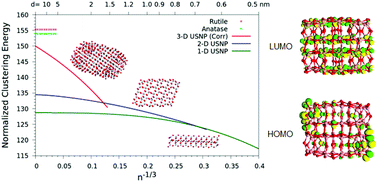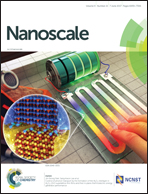Modeling the formation of TiO2 ultra-small nanoparticles†
Abstract
The structures of TiO2 ultra-small nanoparticles (USNPs) at the atomistic level have been predicted because of their potential importance in catalytic, environmental, biological and energy applications. Low energy (TiO2)n clusters and USNPs (n up to 80 at the B3LYP/DZVP2 level, and up to 384 at the PM6 level) were found using a novel bottom-up global optimization approach that is based on all-atom real-space calculations. These structures include USNPs that belong to 1-D, 2-D and 3-D USNP series where all the members share the same fragment types and local translational symmetries. Most of the metastable 2-D and 3-D USNPs contain tubular building blocks similar to the 1-D USNPs. The 3-D USNPs that resemble the bulk anatase are predicted to be energetically favorable structures for 64 ≤ n ≤ 384. A fragment-based model was developed to relate the energy with geometry for the 1-D, 2-D and 3-D USNPs. Surface energy densities were predicted for surface fragments at the different positions of the USNPs using this new model. Based on the predicted surface energy densities and the partial density of states, the most catalytically active sites for the anatase-like 3-D USNPs were predicted to be the kink sites on Face-x surfaces consisting of an octahedral-Ti, the step (edge) sites between the Face-x and Face-y surfaces consisting of a square pyramidal-Ti (on Face-x), and the step sites consisting of a trigonal bipyramidal Ti on the Face-y surfaces.



 Please wait while we load your content...
Please wait while we load your content...